Ansoff Matrix
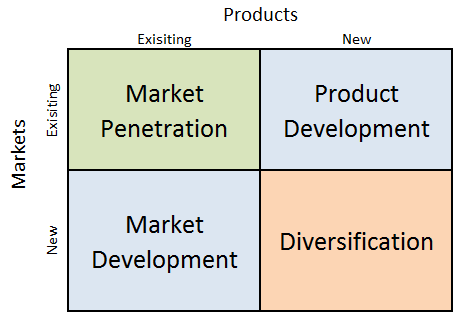
Marriott Ansoff Matrix is a marketing planning model that helps the international hotel chain to determine its product and market strategy. Ansoff Matrix illustrates four different strategy options available for businesses. These are market penetration, product development, market development and diversification. Marriott Ansoff Growth Matrix Within the scope of Ansoff Matrix, Marriott International uses all four growth strategies in an integrated manner: 1. Market penetration. Market penetration refers to selling existing products and services to existing markets in increased quantities. Market penetration is one of the main growth strategies for Marriott. The company uses this strategy through competitive pricing for some of the brands within its portfolio, promotional discounts, targeted marketing and other means. Moreover, Marriott Bonvoy loyalty program plays in instrumental role in increasing the effectiveness of market penetration. 2. Product development. This growth strategy involves developing new products to sell to existing markets. Marriott has a strong track record of developing and launching new brands and hotel concepts that meet the evolving needs of its customers. For example, the company launched several new brands in recent years, such as Moxy Hotels, AC Hotels by Marriott, and Autograph Collection, as well as, new hotel concepts such as Tribute Portfolio and Element Hotels. 3. Market development. Market development strategy is associated with finding new markets for existing products. An extensive focus on market development business strategy has allowed Marriott International to become the largest hotel chain in the world operating in 138 countries and territories under 30 brand names.[1] 4. Diversification. Diversification involves developing new products to sell to new markets and this is considered to be the riskiest strategy. Marriott uses diversification sparingly, preferring to stick to its core hotel business. The rare cases of diversification for the hotel chain include entering into vacation rentals, timeshares and operating…
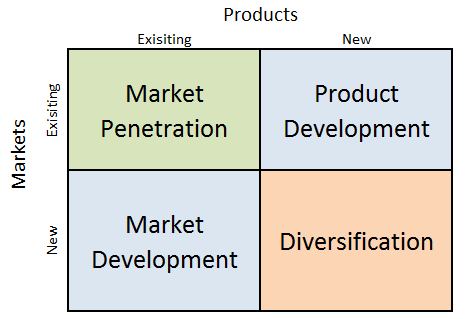
Netflix Ansoff Matrix is a marketing planning model that helps the largest streaming service in the world to determine its product and market strategy. Ansoff Matrix illustrates four different strategy options available for the on-demand media provider. These options are market penetration, product development, market development and diversification. Ansoff Growth Matrix Within the scope of Ansoff Matrix, Netflix uses all four growth strategies in an integrated way: 1. Market penetration. Market penetration refers to selling existing products to existing markets. Netflix engages in market penetration through an effective marketing strategy. The entertainment services provider targets outward-looking, affluent consumers with international credit cards and smartphones and uses anticipatory and mono-segment positioning to appeal to the needs and preferences of this segment. 2. Product development. This strategy involves developing new products to sell to existing markets. Product development is one of the main growth strategies for Netflix. The company is focused on producing original content. Furthermore, the streaming service is developing a growing number of non-English language originals from places such as Mexico, France, Italy, Japan and Brazil, to name just a few. 3. Market development. Market development strategy is associated with finding new markets for existing products. The on-demand media provider uses market development growth strategy extensively since its inception in 1998. Thanks to the successful implantation of this strategy, today Netflix is available virtually everywhere except in China and Russia and it has 231 million paid memberships in over 190 countries. [1] 4. Diversification. Diversification involves developing new products to sell to new markets and this is considered to be the riskiest strategy. The largest streaming service in the world uses diversification growth strategy rarely. Entering into gaming sector in 2021 is the only notable business diversification case for Netflix. Netflix Inc. Report contains the above analysis of Netflix Ansoff…
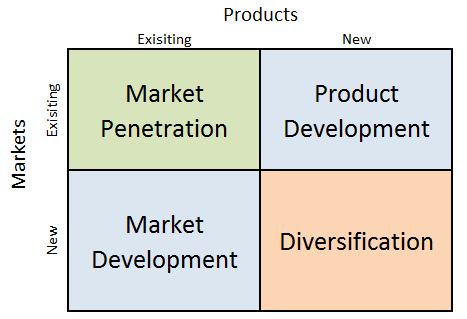
Nvidia Ansoff Matrix is a marketing planning model that helps the GPU producer to determine its product and market strategy. According to Ansoff Matrix there are four different strategy options available for businesses. These are market penetration, product development, market development and diversification. Ansoff Growth Matrix Within the scope of Ansoff Matrix, Nvidia uses all four growth strategies in an integrated manner: 1. Market penetration. Market penetration refers to selling existing products to existing markets. The multinational technology company operates in 32 countries directly and sells its products in many other countries through distributors and re-sellers[1]. Popular market penetration strategies used by Nvidia include print and media advertising, sales promotions, marketing events and experiences, as well as, public relations practices. 2. Product development. This strategy involves developing new products to sell to existing markets. Product development strategy is one of the key growth strategies for Nvidia. In 2021 alone, the company spent over USD 3 billion on R&D, which represented over 20% of its total revenue. Nvidia has invested over USD 29 billion in research and development since its inception.[2] 3. Market development. Market development strategy is associated with finding new markets for existing products and Nvidia uses this strategy to grow the business. Starting only with the US market, the multinational technology company currently operates in 32 countries directly. The company sells its products to many other countries through distributors and re-sellers. 4. Diversification. Diversification involves developing new products to sell to new markets and this is considered to be the riskiest strategy. Nvidia uses diversification extensively, systematically entering new business segments. Starting as 3D graphics producer in 1993, the company expanded product portfolio to produce GPUs in 1999 and immersed itself into AI segment starting from 2012. More recently, Nvidia has further diversified the business to enter cloud…
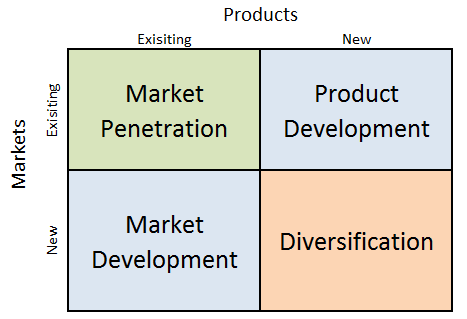
WeWork Ansoff Matrix is a marketing planning model that helps co-working and office space operator to determine its product and market strategy. Ansoff Matrix illustrates four different strategy options available for businesses. These are market penetration, product development, market development and diversification. WeWork Ansoff Growth Matrix Within the scope of Ansoff Matrix, WeWork uses all four growth strategies in an integrated manner: 1. Market penetration. Market penetration refers to selling existing products to existing markets. WeWork engages in market penetration strategy extensively. The global flexible workspace provider uses print and media marketing in general and social media marketing in particular to increase its penetration into the market. 2. Product development. This involves developing new products to sell to existing markets. WeWork engages in new product development rarely. WeWork Workplace software for landlords for online booking of desks, offices, collaboration hubs, and meeting rooms is one of the very few noteworthy cases of new product development by the co-working giant. 3. Market development. Market development strategy is associated with finding new markets for existing products. New market development is one of the main growth strategies for WeWork. Starting only with one location in Manhattan, USA in 2011, the workspace provider has expanded to a network of 756 locations in 38 countries, including 277 locations in the US as of December 2021. 4. Diversification. Diversification involves developing new products to sell to new markets and this is considered to be the riskiest strategy. WeWork does not engage in diversification business strategy, but it may do so in the future. WeWork Inc. Report contains the above analysis of WeWork Ansoff Matrix. The report illustrates the application of the major analytical strategic frameworks in business studies such as SWOT, PESTEL, Porter’s Five Forces, Value Chain analysis and McKinsey 7S Model on WeWork. Moreover,…
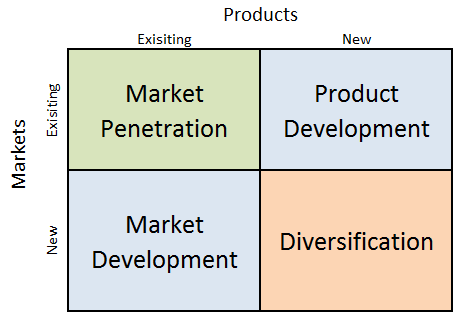
Starbucks Ansoff Matrix is a marketing planning model that helps the multinational chain of coffeehouses to develop its product and market strategy. Ansoff Matrix focuses on four different strategy options businesses can use. These are market penetration, product development, market development and diversification. Ansoff Growth Matrix Starbucks uses all four growth strategies within the scope of Ansoff Matrix. 1. Market penetration. Market penetration refers to selling existing products to existing markets. Starbucks usually has the largest share in the majority of markets it operates. The world’s largest coffeehouse chain relies on its integrated marketing strategy to pursue market penetration strategy. Specifically, the Seattle-based coffee chain effectively positions itself as a third place away from work and home. 2. Product development. This strategy implies developing new products to sell to existing markets. The global coffeehouse chain pursues product development strategy aggressively. The company sells many variations of coffee, tea and other beverages and a variety of fresh food items, including snack under the brand names of Starbucks, Teavana, Seattle’s Best Coffee, Evolution Fresh, Ethos, Starbucks Reserve and Princi. 3. Market development. Market development strategy is associated with finding new markets for existing products. It is one of the main growth tools actively used by Starbucks Corporation. Started with only one coffee shop in Seattle’s 1912 Pike Place in 1971, the company has expended into 84 markets with 17133 company-operated stores and 16700 licensed stores as of October 3, 2021.[1] 4. Diversification. Diversification involves developing new products to sell to new markets and this is considered to be the riskiest strategy. The world’s largest coffeehouse chain engages in diversification sparingly. Rare occasions of diversification by Starbucks include selling CDs with own musical compilations. Starbucks Corporation Report contains the above analysis of Starbucks Ansoff Matrix. The report illustrates the application of the…

McDonald’s Ansoff Matrix is a marketing planning model that helps the fast food giant to determine its product and market strategy. Ansoff Matrix illustrates four different strategy options available for businesses. These are market penetration, product development, market development and diversification. McDonald’s Ansoff Growth Matrix Within the scope of Ansoff Matrix, McDonald’s uses three growth strategies in an integrated manner: 1. Market penetration. Market penetration refers to selling existing products to existing markets. The fast food chain engages in market penetration growth strategy through efficient implementation of integrated marketing strategy. 2. Product development. This involves developing new products to sell to existing markets. McDonald’s introduces new items on its menu in a regular manner on par with changes in customer tastes and preferences. For example, latest additions in the menu include The Hash Brown McMuffin, The Crunchy Double, The Land, Air & Sea and The Surf + Turf. 3. Market development. Market development strategy is associated with finding new markets for existing products. Market development through franchising has been one of the main growth strategies for McDonald’s since the purchase of the company by Ray Krock from the founder brothers Richard and Maurice McDonald. Thanks to successful application of this strategy, currently there are 40,031McDonald’s restaurants in119 countries.[1] 4. Diversification. Diversification involves developing new products to sell to new markets and this is considered to be the riskiest strategy. Up to date McDonald’s has not diversified outside of its core business of selling food through franchising and company-operating stores and generating revenues from real estate leased to franchisees. McDonald’s Corporation Report contains the above analysis of McDonald’s Ansoff Matrix. The report illustrates the application of the major analytical strategic frameworks in business studies such as SWOT, PESTEL, Porter’s Five Forces, Value Chain analysis and McKinsey 7S Model on McDonald’s. Moreover,…

Square Ansoff Matrix is a marketing planning model that helps the B2B fintech to determine its product and market strategy. Ansoff Matrix illustrates four different strategy options available for businesses. These are market penetration, product development, market development and diversification. Square Ansoff Matrix Within the scope of Ansoff Matrix, Square uses all four growth strategies in an integrated manner: 1. Market penetration. Market penetration refers to selling existing products to existing markets. Square uses market penetration strategy extensively. Specifically, the payments company relies on viral marketing based on storytelling along with other marketing strategies to sell its financial products and services to small and medium businesses in North America, Canada, Japan, Australia, Republic of Ireland and the United Kingdom. Furthermore, the financial services and digital payments company offers individuals on the same locations listed above the services of storing, sending, receiving, spending and investing their money. 2. Product development. This involves developing new products to sell to existing markets. New product development is the main growth strategy for Square. Having entered the market only with a card reader, nowadays Square offers more than 30 distincg products and services for businesses and increasing numbers of products and services to individuals. . Each new product developed by Square further strengthens its expanding ecosystem of financial products and services. The financial services and mobile payments company is expected to further engage in product development strategy in an accelerated rate. 3. Market development. Market development strategy is associated with finding new markets for existing products. Square is cautious and overly selective in expanding in new markets. Moreover, there are entry barriers for the financial unicorn such as the level of financial infrastructure, regulatory barriers and the level of technological savvy for consumers. 4. Diversification. Diversification involves developing new products to sell to new markets…
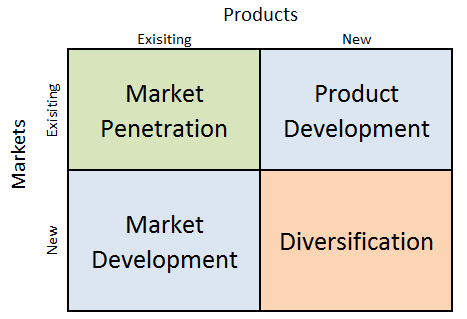
W.W. Grainger Ansoff Matrix is a marketing planning model that helps the global industrial supply company to determine its product and market strategy. Ansoff Matrix illustrates four different strategy options available for businesses. These are market penetration, product development, market development and diversification. W.W. Grainger Ansoff Matrix Within the scope of Ansoff Matrix, Grainger uses all growth strategies except diversification growth strategy in the following manner: 1. Market penetration. Market penetration involves selling existing products to existing markets. Grainger sells about 1,7 million types of MRO products covering a wide range of product categories.[1] The industrial supply company sustains market penetration business strategy via developing and maintaining relationships with customers through sales and service representatives and digital solutions. 2. Product development. This growth strategy is associated with developing new products to sell to existing markets. Grainger does not produce any product in-house, but continually expands its supplier base for new MRO products. Particularly, the worldwide distributor of industrial products is focused on expanding SKUs in its Zoro and MonotaRO subsidiaries to offset increasing competition from Amazon Business. In 2019 the company added about 1,5 million SKUs to its Zoro US assortment to increase it to approximately 3,5 million products.[2] 3. Market development. Market development strategy is associated with finding new markets for existing products. Currently, the B2B distributor has 456 branches and 30 distribution centres in US, Canada, Latin America, Japan and Europe. The worldwide distributor of industrial products may enter market in Asia in the foreseeable future[3]. Grainger enters new markets with Endless Assortment business model with a single online sales channel. Later, MRO products distributor may shift to High-Touch Solutions model in any given market if there is growing demand from large customers with more complex needs. 4. Diversification. Diversification involves developing new products to sell to new…
